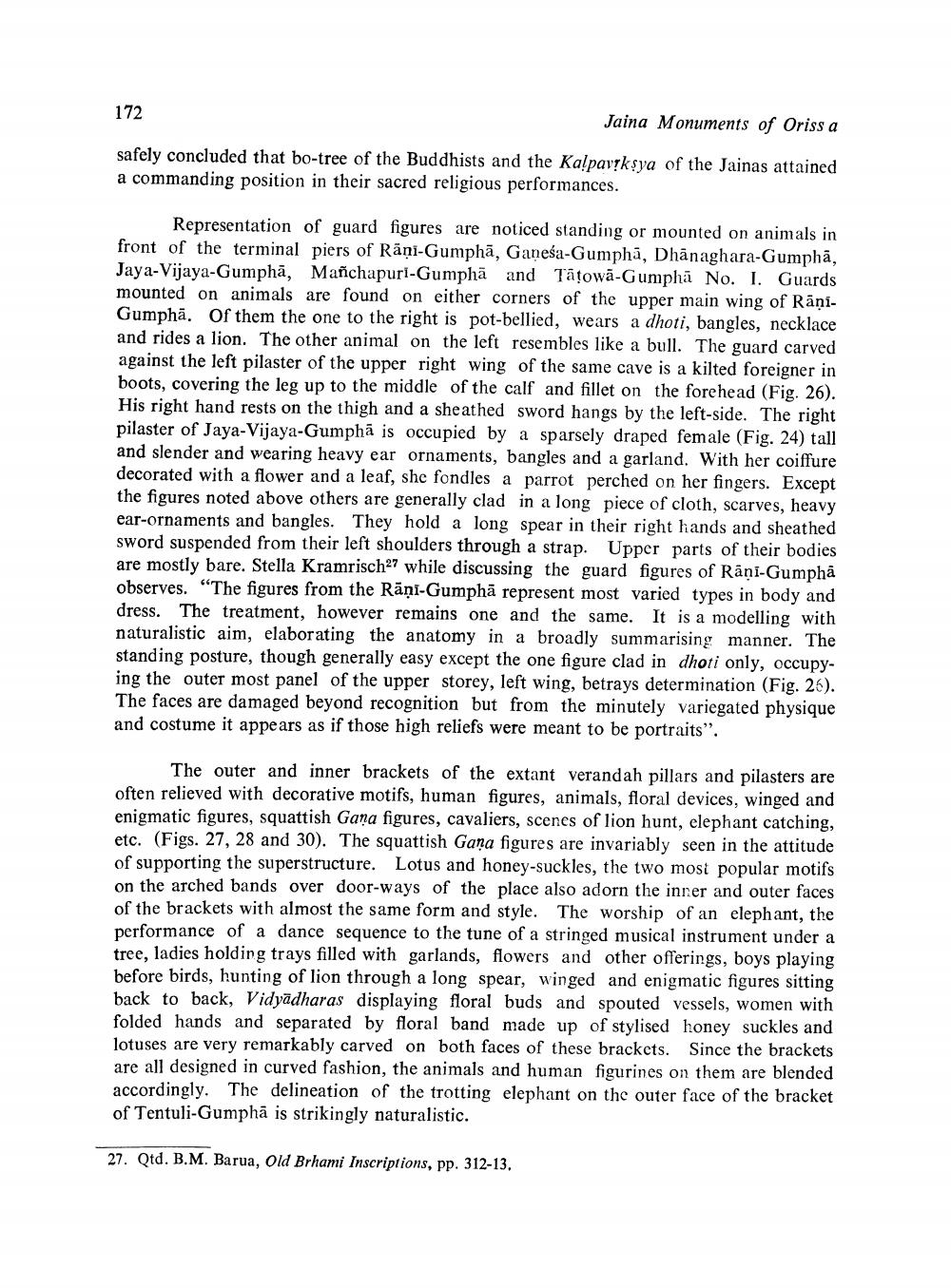________________
172
Jaina Monuments of Oriss a
safely concluded that bo-tree of the Buddhists and the Kalpavşkşya of the Jainas attained a commanding position in their sacred religious performances.
Representation of guard figures are noticed standing or mounted on animals in front of the terminal piers of Rāņi-Gumphā, Ganesa-Gumphā, Dhānaghara-Gumphā, Jaya-Vijaya-Gumphā, Mañchapuri-Gumpha and Tätowā-Gumphā No. I. Guards mounted on animals are found on either corners of the upper main wing of RāņiGumphā. Of them the one to the right is pot-bellied, wears a dhoti, bangles, necklace and rides a lion. The other animal on the left resembles like a bull. The guard carved against the left pilaster of the upper right wing of the same cave is a kilted foreigner in boots, covering the leg up to the middle of the calf and fillet on the forehead (Fig. 26). His right hand rests on the thigh and a sheathed sword hangs by the left side. The right pilaster of Jaya-Vijaya-Gumphā is occupied by a sparsely draped female (Fig. 24) tall and slender and wearing heavy ear ornaments, bangles and a garland. With her coiffure decorated with a flower and a leaf, she fondles a parrot perched on her fingers. Except the figures noted above others are generally clad in a long piece of cloth, scarves, heavy ear-ornaments and bangles. They hold a long spear in their right hands and sheathed sword suspended from their left shoulders through a strap. Upper parts of their bodies are mostly bare. Stella Kramrisch27 while discussing the guard figures of Rāņi-Gumphā observes. “The figures from the Rāņi-Gumphā represent most varied types in body and dress. The treatment, however remains one and the same. It is a modelling with naturalistic aim, elaborating the anatomy in a broadly summarising manner. The standing posture, though generally easy except the one figure clad in dhoti only, occupying the outer most panel of the upper storey, left wing, betrays determination (Fig. 26). The faces are damaged beyond recognition but from the minutely variegated physique and costume it appears as if those high reliefs were meant to be portraits".
The outer and inner brackets of the extant verandah pillars and pilasters are often relieved with decorative motifs, human figures, animals, floral devices, winged and enigmatic figures, squattish Gana figures, cavaliers, scenes of lion hunt, elephant catching, etc. (Figs. 27, 28 and 30). The squattish Gana figures are invariably seen in the attitude of supporting the superstructure. Lotus and honey-suckles, the two most popular motifs on the arched bands over door-ways of the place also adorn the inner and outer faces of the brackets with almost the same form and style. The worship of an elephant, the performance of a dance sequence to the tune of a stringed musical instrument under a tree, ladies holding trays filled with garlands, flowers and other offerings, boys playing before birds, hunting of lion through a long spear, winged and enigmatic figures sitting back to back, Vidyādharas displaying floral buds and spouted vessels, women with folded hands and separated by floral band made up of stylised honey suckles and lotuses are very remarkably carved on both faces of these brackets. Since the brackets are all designed in curved fashion, the animals and human figurines on them are blended accordingly. The delineation of the trotting elephant on the outer face of the bracket of Tentuli-Gumphā is strikingly naturalistic.
27. Qtd. B.M. Barua, Old Brhami Inscriptions, pp. 312-13,




